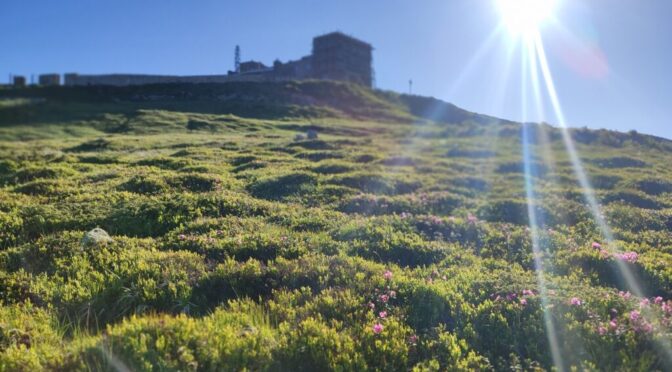A Radnote radiation monitoring station has been installed on Mount Pip Ivan Chornohorskyi, one of the highest peaks in the Ukrainian Carpathians, standing at an altitude of 2,028.5 metres. This has been made possible through cooperation of Vasyl Stefanyk Precarpathian National University with NGO SaveDnipro and international partnerships with SAFECAST and Blues.
It is worth noting that a key advantage of the Radnote stations is their autonomous operation. They require neither a mains electricity supply nor a wired or Wi-Fi Internet connection. Radnote functions perfectly in standalone mode, powered by an integrated solar panel and transmitting data via the mobile network – a fact proven by its uninterrupted operation in the Chornobyl Exclusion Zone and during last year’s stabilisation power outages. Thanks to these features, Radnote is an ideal solution for remote locations such as Mount Pip Ivan. At an altitude of over 2,000 metres, winter temperatures often fall below -20⁰C, and wind speeds can exceed 50 km/h; everything is covered in thick layers of snow and ice for weeks or even months. For some radiation monitoring stations, low temperatures present a risk of malfunction. And now we have the opportunity to test the system under the most severe conditions. The mountain’s proximity of the station to the EU border makes it an important site for cross-border monitoring, which will contribute to data exchange and coordination efforts between Ukraine and the European Union.
Radiation data from Mount Pip Ivan can be viewed on the SaveEcoBot radiation map: https://www.saveecobot.com/radiation-maps#12/48.0695/24.6441/gamma/ara+arc+clua+cuc+crc
From the system, the data are automatically transmitted to Deepstatemap.live, Windy.com, and other platforms that integrate SaveEcoBot data. In particular, the system shares data with the official Ministry of Environmental Protection and Natural Resources platform “EcoThreat”, as well as with State Nuclear Regulatory Inspectorate, State Scientific and Technical Center for Nuclear and Radiation Safety, the National Security and Defence Council of Ukraine; it is also displayed on the website of the National Commission for Radiation Protection of the Population of Ukraine and published via the State Open Data Portal.
Furthermore, the data collected from the Radnote station on Mount Pip Ivan will also be published in the open data repository DataSet of Vasyl Stefanyk Precarpathian National University (established under the OSCARS project “Advanced Materials Open Science Centre at the Precarpathian National University – PNU-OpenLab”). These data are openly accessible and may be freely used by researchers, civil society organisations, and public authorities for scientific, environmental, and policy-related purposes. This is in line with the objectives of the Jean Monnet Module project “Radiation Safety: European-Ukrainian Approach”, which is being implemented at the Department of Applied Physics and Materials Science.
The online presentation of the partnership’s results featured Ihor Tsependa, Acting Rector of the Precarpathian National University, Volodymyr Kotsiubynskyi, Head of the Department of Applied Physics and Materials Science, Pavlo Tkachenko, co-founder of SaveDnipro, Head of IT and Chief Developer of SaveEcoBot (Dnipro), Azbi Brown, Lead Researcher at Safecast (Yokohama, Japan), and the university’s scientific community.
We sincerely thank Pavlo Tkachenko and Azba Brown for their valuable cooperation and contribution to the implementation of this important project for Ukraine. We thank the Armed Forces of Ukraine for the opportunity to work.









